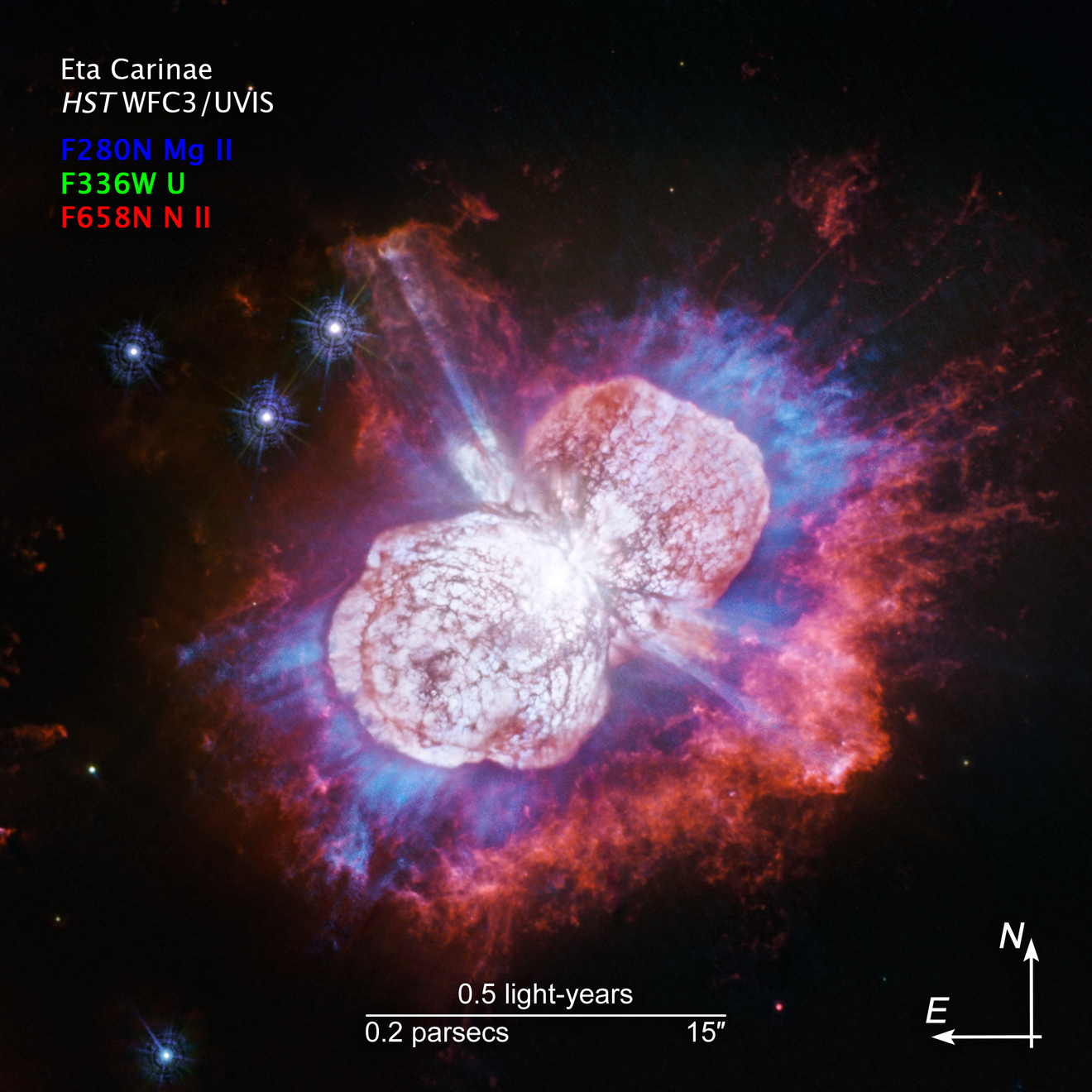1 min read
Eta Carinae: Observations in UV Light Uncover Magnesium Embedded in Warm Gas

Giant Star Yields New Clues About Turbulent Life
This Hubble Space Telescope image of the giant, petulant star Eta Carinae is yielding new surprises.
Telescopes such as Hubble have monitored the super-massive star for more than two decades. The star, the largest member of a double-star system, has been prone to violent outbursts, including an episode in the 1840s during which ejected material formed the bipolar bubbles seen here.
Now, using Hubble's Wide Field Camera 3 to probe the nebula in ultraviolet light, astronomers have uncovered the glow of magnesium embedded in warm gas (shown in blue) in places they had not seen it before. The luminous magnesium resides in the space between the dusty bipolar bubbles and the outer shock-heated nitrogen-rich filaments (shown in red).
The streaks visible in the blue region outside the lower-left lobe are a striking feature in the image. These streaks are created when the star's light rays poke through the dust clumps scattered along the bubble's surface. Wherever the ultraviolet light strikes the dense dust, it leaves a long, thin shadow that extends beyond the lobe into the surrounding gas.
Eta Carinae resides 7,500 light-years away.
About the Object
- R.A. PositionR.A. PositionRight ascension – analogous to longitude – is one component of an object's position.10:45:03.546
- Dec. PositionDec. PositionDeclination – analogous to latitude – is one component of an object's position.-59:41:03.95
- ConstellationConstellationOne of 88 recognized regions of the celestial sphere in which the object appears.Carina
- DistanceDistanceThe physical distance from Earth to the astronomical object. Distances within our solar system are usually measured in Astronomical Units (AU). Distances between stars are usually measured in light-years. Interstellar distances can also be measured in parsecs.7,500 light-years away from Earth
- DimensionsDimensionsThe physical size of the object or the apparent angle it subtends on the sky.Image is about 45 arcseconds across (about 1.6 light-years)
About the Data
- Data DescriptionData DescriptionProposal: A description of the observations, their scientific justification, and the links to the data available in the science archive.
Science Team: The astronomers who planned the observations and analyzed the data. "PI" refers to the Principal Investigator. - InstrumentInstrumentThe science instrument used to produce the data.WFC3/UVIS
- Exposure DatesExposure DatesThe date(s) that the telescope made its observations and the total exposure time.March 2018 and July 2018
- FiltersFiltersThe camera filters that were used in the science observations.F280N, F336W, and F658N
- Object NameObject NameA name or catalog number that astronomers use to identify an astronomical object.Eta Carinae
- Object DescriptionObject DescriptionThe type of astronomical object.Variable Star and Outer Ejecta
- Release DateJuly 1, 2019
- Science ReleaseHubble Captures the Galaxy’s Biggest Ongoing Stellar Fireworks Show
- Credit

These images are a composite of separate exposures acquired by the WFC3/UVIS instrument on the Hubble Space Telescope. Several filters were used to sample narrow and wide wavelength ranges. The color results from assigning different hues (colors) to each monochromatic (grayscale) image associated with an individual filter. In this case, the assigned colors are: Blue: F280N Green: F336W Red: F658N

Share
Details
Claire Andreoli
NASA’s Goddard Space Flight Center
Greenbelt, Maryland
claire.andreoli@nasa.gov
































